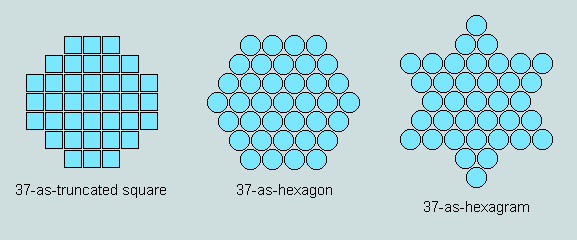
In an earlier page 37 was depicted as a bifigurate numero-geometrical object. However, it is actually trifigurate - as the following figures prove. In other words, 37 counters laid out on a flat surface may be arranged in 3 distinct ways to form a symmetrical pattern, thus:

In this respect 37 is unique among the numbers.
Of particular interest to this account is the second of the 3 forms, the hexagon, in that this may be perceived as a representation of a 4x4x4 cube comprising 64 counters.

At (a) we have the normal hexagonal arrangement of 37 counters, and at (b) a typical representation of a cube - its outline taking the form of a hexagon. The salient features of this cube are shown superimposed on the hexagon at (c). Finally, at (d) we show a symbolic representation of the visual transformation hexagon ---> cube. We shall have occasion to use this symbol in the following section.